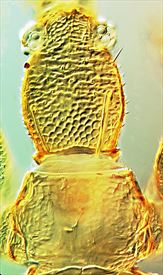Distinguishing features
Both sexes wingless. Body brownish-yellow, darkest on posterior segments; antennal segments I–III yellow, IV–V pale brown, VI–VIII brown. Head longer than wide, protruding in front of eyes; cheeks rounded, sharply constricted at base; dorsal surface strongly reticulate; ocelli absent; compound eyes small, protruding; postocular setae small; maxillary stylets arranged in V-shape, retracted about halfway towards eyes. Antennae 8-segmented; segments II–VI strongly sculptured; III with 2 long sense cones, IV with 3. Pronotum finely sculptured; no setae elongate; basantra small. Metanotum transverse; metathoracic sternopleural sutures long, curved. Fore tarsal tooth absent. Pelta broadly oval, bearing a transverse sub-basal line; tergites strongly reticulate; tergite IX with postero-marginal setae long, pointed, less than half as long as tube; tube shorter than head, weakly sculptured; anal setae relatively long and fine
Male similar to female, but postocular setae well developed, 45 microns long; fore tarsal tooth recurved, large in large individuals; fore femora swollen.
Related species
Only one species is known in this genus. This was placed by Mound & Palmer (1983) in the subtribe Compsothripina of the Pygothripini, suggesting a relationship to Bolothrips and Compsothrips, two genera that are widespread around the world with species living at ground level.
Biological data
Feeding on fungal spores, and breeding at the base of grasses and in leaf litter.
Distribution data
Described originally from New Zealand (AK), where it has been collected in January, March, May and August. Subsequently the species was recorded from southeastern Australia and then found in abundance on Norfolk Island (Mound & Wells, 2015).
Family name
PHLAEOTHRIPIDAE, IDOLOTHRIPINAE
Species name
Anaglyptothrips dugdalei Mound & Palmer
Original name and synonyms
Anaglyptothrips dugdalei Mound & Palmer, 1983: 35
References
Mound LA & Palmer JM (1983) The generic and tribal classification of spore-feeding Thysanoptera (Phlaeothripidae: Idolothripinae). Bulletin of the British Museum (Natural History). Entomology 46: 1–174.
Mound LA & Walker AK (1986) Tubulifera (Insecta: Thysanoptera). Fauna of New Zealand 10: 1–140.
Mound LA & Wells A (2015) Endemics and adventives: Thysanoptera (Insecta) Biodiversity of Norfolk, a tiny Pacific Island. Zootaxa 3964 (2): 183–210.



